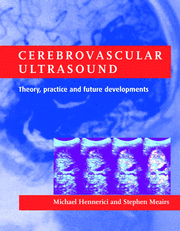Book contents
- Frontmatter
- Dedication
- Contents
- List of contributors
- Preface
- PART I ULTRASOUND PHYSICS, TECHNOLOGY AND HEMODYNAMICS
- PART II CLINICAL CEREBROVASCULAR ULTRASOUND
- (i) Atherosclerosis: pathogenesis, early assessment and follow-up with ultrasound
- 8 Morphogenesis of the atherosclerotic plaque
- 9 Hemodynamics and atherosclerosis
- 10 Carotid artery intima-media thickness
- 11 Non-invasive evaluation of endothelial function with B-mode ultrasound imaging of flow-induced brachial artery reactivity
- 12 Plaque characterization and risk profiles
- 13 Natural history of asymptotic carotid stenosis
- (ii) Extracranial cerebrovascular applications
- (iii) Intracranial cerebrovascular applications
- PART III NEW AND FUTURE DEVELOPMENTS
- Index
9 - Hemodynamics and atherosclerosis
from (i) - Atherosclerosis: pathogenesis, early assessment and follow-up with ultrasound
Published online by Cambridge University Press: 05 July 2014
- Frontmatter
- Dedication
- Contents
- List of contributors
- Preface
- PART I ULTRASOUND PHYSICS, TECHNOLOGY AND HEMODYNAMICS
- PART II CLINICAL CEREBROVASCULAR ULTRASOUND
- (i) Atherosclerosis: pathogenesis, early assessment and follow-up with ultrasound
- 8 Morphogenesis of the atherosclerotic plaque
- 9 Hemodynamics and atherosclerosis
- 10 Carotid artery intima-media thickness
- 11 Non-invasive evaluation of endothelial function with B-mode ultrasound imaging of flow-induced brachial artery reactivity
- 12 Plaque characterization and risk profiles
- 13 Natural history of asymptotic carotid stenosis
- (ii) Extracranial cerebrovascular applications
- (iii) Intracranial cerebrovascular applications
- PART III NEW AND FUTURE DEVELOPMENTS
- Index
Summary
Introduction
The effect of local hemodynamics on the development and progression of atherosclerotic disease has been the subject of speculation, theory, and research for over 100 years. The argument that altered hemodynamics plays a role in atherosclerosis is compelling: small, non-branching, and straight sections of the vasculature are relatively disease free while large arteries near branch ostia, bifurcations, and bends are disease prone. Curves and branches create regions of both high and low fluid velocity, flow separation and other departures from unidirectional, smooth flow. They are also regions of altered mural tensile stress which may change artery wall compliance, composition and metabolism. The altered hemodynamics and solid mechanics at curves and branches likely affect both delivery and accumulation of atherogenic substances at these locations. However, some bending and branching vessels such as the thoracic aorta, the mesenteric and internal mammary arteries remain free of disease in individuals with advanced disease.
Hemodynamics may interact with the arterial structure and function along several pathways. Biologically, the artery wall may respond to changes in its environment such as wall shear stress, pressure, and chemical species concentration by altering cell proliferation, morphology, permeability and receptor availability. Physically, when atherosclerotic vessels form stenoses, the wall shape changes so dramatically that the flow around the stenosis is altered. These flow patterns have their own role in the progression of the disease, as well as in the diagnosis of the disease.
- Type
- Chapter
- Information
- Cerebrovascular UltrasoundTheory, Practice and Future Developments, pp. 134 - 151Publisher: Cambridge University PressPrint publication year: 2001
- 1
- Cited by



